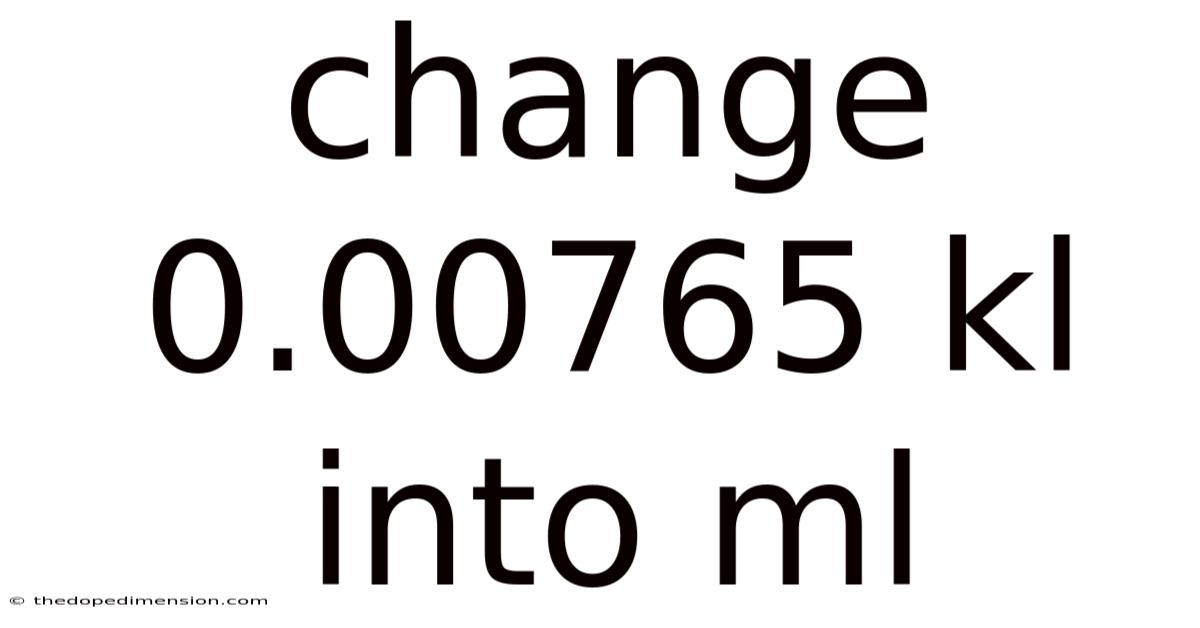Change 0.00765 Kl Into Ml
thedopedimension
Sep 13, 2025 · 4 min read

Table of Contents
Converting 0.00765 kl to ml: A Comprehensive Guide to Metric Conversions
Understanding metric conversions is crucial in various fields, from science and engineering to everyday life. This article provides a step-by-step guide on how to convert 0.00765 kiloliters (kl) to milliliters (ml), explaining the underlying principles and offering helpful tips for similar conversions. We'll delve into the logic behind the conversion, explore the relevant prefixes in the metric system, and address frequently asked questions to ensure a thorough understanding. By the end, you'll not only know the answer but also be equipped to tackle other metric conversion problems with confidence.
Understanding the Metric System
The metric system, or International System of Units (SI), is a decimal system based on powers of 10. This makes conversions relatively straightforward. The system uses prefixes to indicate multiples or submultiples of the base unit. For volume, the base unit is the liter (l). Key prefixes relevant to this conversion include:
- kilo (k): Represents 1000 times the base unit (1 kl = 1000 l)
- milli (m): Represents 1/1000 of the base unit (1 l = 1000 ml)
Step-by-Step Conversion: 0.00765 kl to ml
The conversion from kiloliters (kl) to milliliters (ml) involves two steps:
Step 1: Convert kiloliters to liters
Since 1 kiloliter is equal to 1000 liters, we multiply the given value in kiloliters by 1000:
0.00765 kl * 1000 l/kl = 7.65 l
Step 2: Convert liters to milliliters
Knowing that 1 liter equals 1000 milliliters, we multiply the value obtained in Step 1 by 1000:
7.65 l * 1000 ml/l = 7650 ml
Therefore, 0.00765 kl is equal to 7650 ml.
A Deeper Dive into the Conversion Process
The conversion process fundamentally relies on the relationship between the prefixes kilo and milli within the metric system. Let's break down the logic further:
-
Understanding Prefixes: The prefixes are crucial. Kilo indicates a multiplication factor of 10³, while milli indicates a multiplication factor of 10⁻³.
-
Combining Prefixes: To convert from kiloliters to milliliters, we are essentially going from 10³ to 10⁻³. This represents a change of 10⁶ (10³ / 10⁻³ = 10⁶).
-
The Conversion Factor: This means that 1 kiloliter is equal to 1,000,000 milliliters (10⁶ ml).
-
Applying the Conversion Factor: To convert 0.00765 kl to ml, we multiply by this conversion factor:
0.00765 kl * 1,000,000 ml/kl = 7650 ml
This approach provides a more concise understanding of the underlying mathematical principles behind the conversion.
Practical Applications and Real-World Examples
Understanding metric conversions is vital in many real-world scenarios:
-
Science and Engineering: Accurate measurements are paramount in scientific experiments and engineering projects. Converting between units is essential for consistency and accuracy in calculations.
-
Cooking and Baking: Recipes often require precise measurements, and converting between units ensures accurate results.
-
Medicine: Accurate dosages are critical in medicine, requiring precise conversions between different units of volume and mass.
-
Manufacturing and Industry: Many industrial processes rely on precise measurements, making unit conversions necessary for production efficiency and quality control.
Troubleshooting Common Mistakes
While the conversion is relatively straightforward, some common mistakes can occur:
-
Incorrect Multiplication/Division: Ensure you are multiplying when converting from a larger unit to a smaller unit (e.g., kl to ml) and dividing when converting from a smaller unit to a larger unit (e.g., ml to kl).
-
Forgetting the Conversion Factor: Remembering the relationships between the prefixes (kilo, milli, etc.) is crucial. A simple mistake here can lead to significant errors.
-
Misinterpreting Decimal Points: Pay close attention to decimal points to avoid errors in calculations.
Frequently Asked Questions (FAQ)
Q1: Can I convert directly from kl to ml without the intermediate step of converting to liters?
A1: Yes, absolutely! As explained earlier, you can use the direct conversion factor of 1,000,000 ml/kl (10⁶). This method combines both steps into one calculation, resulting in the same answer.
Q2: What if I need to convert from milliliters to kiloliters?
A2: To convert from milliliters to kiloliters, you would divide by 1,000,000 (or perform the reverse steps as shown above).
Q3: Are there other units of volume in the metric system?
A3: Yes, many other units exist, including hectoliters (hl), decaliters (dal), deciliters (dl), and centiliters (cl). These are all related to liters through powers of 10.
Q4: How does this relate to cubic units (like cubic meters or cubic centimeters)?
A4: There is a direct relationship between liters and cubic units. 1 liter is exactly equal to 1 cubic decimeter (dm³), and 1 milliliter is equal to 1 cubic centimeter (cm³).
Conclusion
Converting 0.00765 kl to ml involves a simple yet fundamental understanding of the metric system and its prefixes. By mastering this conversion, you gain a valuable skill applicable in diverse fields. Remember the key steps: convert kiloliters to liters (multiply by 1000), then convert liters to milliliters (multiply by 1000 again), resulting in a final answer of 7650 ml. Understanding the underlying principles of the metric system and practicing these conversions will build your confidence and proficiency in handling various measurement units. This knowledge will prove invaluable in your academic pursuits, professional endeavors, and everyday life. Through consistent practice and a firm grasp of the fundamental principles, you'll become adept at navigating the world of metric conversions with ease.
Latest Posts
Latest Posts
-
20 000 Dirham To Usd
Sep 14, 2025
-
20ml Equals How Many Tablespoons
Sep 14, 2025
-
How Long Is 76 Hours
Sep 14, 2025
-
Convert 106 Lbs To Kg
Sep 14, 2025
-
South Sudan Pound To Usd
Sep 14, 2025
Related Post
Thank you for visiting our website which covers about Change 0.00765 Kl Into Ml . We hope the information provided has been useful to you. Feel free to contact us if you have any questions or need further assistance. See you next time and don't miss to bookmark.